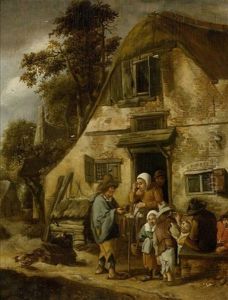Nicolaes Hals Paintings
Nicolaes Hals was a Dutch Golden Age painter, born in 1628 in Haarlem, Netherlands. He was the fifth child of the renowned portraitist Frans Hals. Growing up in a family deeply entrenched in the art world, Nicolaes was exposed to painting from a young age. Alongside his brothers, he was trained by his father, absorbing the influence of his father's lively brushwork and keen observation of human character. Despite the overshadowing fame of Frans Hals, Nicolaes developed his own artistic identity, primarily focusing on genre scenes, portraits, and landscapes.
Nicolaes Hals's work, though not as widely recognized as that of his father, exhibits a keen eye for detail and a penchant for capturing the spontaneity of his subjects, much like his father. His genre scenes are characterized by a lively and often humorous portrayal of daily life, reflecting the social customs and mores of his time. He also painted a number of portraits, in which he demonstrated a more subdued and refined approach compared to the vigorous style of his father. Nicolaes's landscapes, a lesser-known aspect of his oeuvre, show an appreciation for the natural beauty of the Dutch countryside, rendered with a delicate touch and attention to atmospheric effects.
Despite his talents, Nicolaes did not achieve the same level of success and recognition as his father. Historical records suggest that he spent most of his life in Haarlem, where he worked and contributed to the local art scene. The lack of extensive documentation has led to some of his works being misattributed to other artists, including his father and brothers. This, combined with the towering reputation of Frans Hals, has meant that Nicolaes's contribution to Dutch Golden Age painting has only been modestly acknowledged.
Nicolaes Hals passed away in 1686 in Haarlem. Today, his works are held in several museums and collections worldwide, where they are appreciated for their charm, technical skill, and as an extension of the Hals family's artistic legacy. His paintings offer a glimpse into the 17th-century Dutch society, with a particular focus on the middle and lower classes, and contribute to our understanding of the era's social and cultural life. Although Nicolaes may not have achieved the fame of his father, his work remains a valuable part of the Dutch Golden Age's artistic tapestry.





